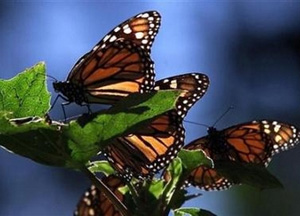 |
 |
 |
 News Around the Republic of Mexico | December 2006 News Around the Republic of Mexico | December 2006  
Butterfly Enthusiasts Find Their Heaven is South of the Border
 Sean Mattson - SA Express-News Sean Mattson - SA Express-News


| | Butterfly enthusiasts, like birders, measure success by the number of species they've seen in the wild. |
Ciudad Victoria, Mexico From piles of poop to puddles in parking lots, a group of South Texas naturalists left no square foot unscrutinized as they fanned out across the northern Mexican state of Tamaulipas recently in search of brilliantly colored bugs.

Most of the spots visited during their five-day butterfly-watching excursion including the verdant foothills of El Cielo cloud forest were, of course, much prettier, but Janet Rathgen wanted to make a point.

"We were looking at the dead butterflies in (a gas station) parking lot to see if we could see something new," said Rathgen, 44, a jovial Houston resident and longtime butterfly lover. "We're not ashamed to look anywhere."

Butterflying is one of ecotourism's latest trends and Americans with a passion for nymphalids, metalmarks and hairstreaks common names for families of butterflies are finding that "anywhere" often means south of the border.

While South Texas is a North American butterfly hot spot, most of the New World's estimated 10,000 butterfly species are tropical, said Kim Garwood, a Mission-based naturalist leading the butterfly hobbyist charge southward.

Garwood, 54, like many butterfly enthusiasts, started as a birder.

When she switched to butterflying 10 years ago, she found it meant more than exploring new geographic territory. Although academia had the bugs fairly well studied, there was a dearth of resources for the hobbyist.

So Garwood and fellow enthusiast Richard Lehman, a retired teacher from Weslaco, compiled what's believed to be the first field guide to the butterflies of Northeastern Mexico, encompassing the three-state region of Tamaulipas, Nuevo Leσn (which helped foot the bill along with the federal government) and San Luis Potosν.

"Butterflying is where birding was 50 or 100 years ago," Garwood said.

Garwood and Lehman, 62, have become unofficial South Texas gurus of butterflying in the region. Newcomers said they wouldn't know where they'd be without the duo, who guided the second annual El Cielo Butterfly Festival in early November.

"I don't think we could have done this trip without (the field guide) and these two," said Susan Schott, a Chattanooga, Tenn., native who was part of the 15-member group.

Butterfly enthusiasts, like birders, measure success by the number of species they've seen in the wild.

The three Mexican states, especially those parts south of the Tropic of Cancer, have some 650 species, roughly twice as many as South Texas.

"For sheer numbers, it's hard to beat this," Garwood said.

"You can spend a weekend in (Ciudad) Victoria ... and see 200 species," she said, standing by a river in Novillo Canyon, just outside the Tamaulipas capital. "What's amazing is that we're so close to the border."

Butterflies have short life cycles and populations fluctuate wildly, though the best time of the year to see them is the end of the rainy season in November. Their abundance is directly related to the availability of the specific plant each species needs to develop from egg to caterpillar to chrysalis, so clearing land for farming and other reasons is a constant threat.

But adult specimens also are drawn to puddles and nutrient-rich manure.

mattson.sean@gmail.com | 
 | |
 |



